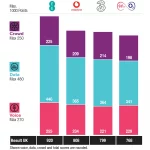2024 vs 2023 – UK Broadband and Mobile Speeds vs the World

Once again we’re ending 2024 by taking a look back to see how the United Kingdom’s position, at least in terms of the top 50 fastest countries for both fixed broadband ISP and mobile (4G, 5G) data speeds, has changed since 2023. Overall, the UK fell from 51st to 53rd for mobile and jumped from 56th to 44th for fixed lines.
The following report was created by harnessing data from Ookla’s popular Speedtest.net service for benchmarking internet connections around the world, which admittedly does have its caveats. For example, the data can be impacted by other aspects of the connection (e.g. slow Wi-Fi, local network congestion, the performance of speedtest.net’s own servers and consumer package choice), but these issues are shared by all of the countries.
However, the main differentiator for speeds between countries tends to stem from the balance between network availability and the take-up of faster connection types. For example, countries with a high coverage of gigabit-capable broadband networks (FTTP, DOCSIS 3.1 – 4.0 etc.) or strong 5G mobile services (ideally with plenty of radio spectrum for them to harness) will naturally rank highest in the table.
Advertisement
In terms of the UK, we’ve seen a strong and continuous improvement in the availability of both faster fixed and mobile networks. For example, Ofcom recently revealed (here) that 1Gbps capable fixed gigabit broadband networks had reached 84% of premises (up from 78% last year), which falls to 69% when only looking at full fibre / FTTP lines (up from 57%).
As for 5G mobile, it is now available from at least one MNO (operator) in the vicinity of around 90-95% of UK premises (up from 85-93% last year) or 61-79% when looking at outside areas with availability from all operators combined.
Top 50 Fastest Countries for Broadband in 2024
The data below reveals that fixed line broadband and mobile speeds have continued to improve across the world. But despite some noted improvements in 5G coverage, other countries still seem able to improve their real-world mobile performance at a faster or similar pace. On the flip side, the UK has seen its first ranking improvement for fixed line performance in several years, which reflects the growing coverage and take-up of full fibre lines.
We’ve summarised some of the key changes below.
Advertisement
UK Fixed & Mobile Speeds vs The World (2024)
| Performance Categories | 2024 | 2023 |
| UK Country Rank for Fixed Line | 44th | 56th |
| Global Latency – Fixed Line | 9ms | 9ms |
| Global Upload – Fixed Line | 50.26Mbps | 40.45Mbps |
| Global Download – Fixed Line | 94.52Mbps | 87.79Mbps |
| UK Latency – Fixed Line | 13ms | 13ms |
| UK Upload – Fixed Line | 30.28Mbps | 24.58Mbps |
| UK Download – Fixed Line | 117.49Mbps | 84.93Mbps |
| UK Country Rank for Mobile | 53rd | 51st |
| Global Latency – Mobile | 27ms | 27ms |
| Global Upload – Mobile | 11.33Mbps | 11.03Mbps |
| Global Download – Mobile | 59.15Mbps | 48.47Mbps |
| UK Latency – Mobile | 34ms | 34ms |
| UK Upload – Mobile | 7.64Mbps | 7.24Mbps |
| UK Download – Mobile | 56.34Mbps | 47.65Mbps |
Otherwise, the following tables show how the countries compare, using only download speed as the key measure, across the top 50 countries.
Sadly, Ookla doesn’t make it easy to do the same table for uploads or latency.
Fastest 50 Countries for Fixed Broadband Speed (DL) in 2024
Advertisement
| Country (2024) | Mbps | Country (2023) | Mbps |
| Singapore | 316.99 | Singapore | 264.15 |
| United Arab Emirates | 300.54 | Hong Kong (SAR) | 263.07 |
| Hong Kong (SAR) | 296.97 | Chile | 248.65 |
| Chile | 279.14 | United Arab Emirates | 235.72 |
| United States | 253.34 | China | 230.39 |
| France | 247.35 | Thailand | 218.94 |
| Thailand | 236.12 | United States | 215.72 |
| Denmark | 230.41 | Denmark | 206.8 |
| Iceland | 224.58 | Iceland | 204.8 |
| Romania | 220.66 | France | 200.99 |
| Spain | 217.92 | Romania | 191.36 |
| Switzerland | 214.8 | Spain | 189.37 |
| Israel | 211.64 | Monaco | 187.49 |
| Taiwan | 208.17 | Switzerland | 187.48 |
| Canada | 201.32 | Netherlands | 177.88 |
| Macau (SAR) | 200.39 | Japan | 170.29 |
| Kuwait | 199.27 | Canada | 165.67 |
| Japan | 196.27 | New Zealand | 163.16 |
| China | 194.79 | Macau (SAR) | 160.52 |
| Netherlands | 191.86 | Taiwan | 157.55 |
| Liechtenstein | 187.86 | Andorra | 156.9 |
| Qatar | 186.79 | Kuwait | 153.58 |
| Hungary | 185.94 | Liechtenstein | 152.22 |
| Peru | 185.54 | Portugal | 150.45 |
| Portugal | 182.62 | Hungary | 149.85 |
| New Zealand | 180.75 | Panama | 148.76 |
| Brazil | 180 | Israel | 144.81 |
| South Korea | 168.13 | Uruguay | 143.06 |
| Poland | 167.46 | South Korea | 139.83 |
| Jordan | 158.86 | Brazil | 136.92 |
| Uruguay | 158.83 | Poland | 133.35 |
| Panama | 158.18 | Sweden | 127.33 |
| Colombia | 157.29 | Qatar | 127.04 |
| Sweden | 154.48 | Norway | 123.63 |
| Vietnam | 153.21 | Luxembourg | 117.66 |
| Luxembourg | 152.84 | Colombia | 111.65 |
| Lithuania | 139.37 | Malaysia | 110.8 |
| Ireland | 138.96 | Jordan | 109.58 |
| Norway | 138.36 | Moldova | 108.2 |
| Malta | 129.24 | Malta | 108.19 |
| Moldova | 127.34 | Vietnam | 104.08 |
| Finland | 124.37 | Lithuania | 103.26 |
| Malaysia | 120.8 | Finland | 102.43 |
| United Kingdom | 117.49 | Saudi Arabia | 102.41 |
| Trinidad and Tobago | 116.91 | Trinidad and Tobago | 100.68 |
| Saudi Arabia | 114.37 | Saint Lucia | 99.96 |
| Belgium | 105.21 | Ireland | 94.62 |
| Costa Rica | 98.16 | Peru | 93.52 |
| Ecuador | 94.74 | Barbados | 92.96 |
| Guyana | 94.61 | Philippines | 91.08 |
Fastest 50 Countries for Mobile Speed (DL) in 2024
| Country (2024) | Mbps | Country (2023) | Mbps |
| United Arab Emirates | 428.53 | United Arab Emirates | 269.41 |
| Qatar | 356.74 | Qatar | 206.8 |
| Kuwait | 258.51 | Kuwait | 191.74 |
| Denmark | 149.73 | China | 164.14 |
| Bulgaria | 147.68 | Macau (SAR) | 155.75 |
| South Korea | 146.42 | Norway | 146.02 |
| Netherlands | 142.84 | South Korea | 145.25 |
| Norway | 139.37 | Denmark | 143.63 |
| Luxembourg | 127.57 | Bulgaria | 142.07 |
| Singapore | 123.73 | Iceland | 139.52 |
| Saudi Arabia | 121.94 | Netherlands | 119.34 |
| United States | 116.75 | Saudi Arabia | 106.01 |
| Bahrain | 116.66 | United States | 103.69 |
| China | 115.89 | Australia | 97.44 |
| Finland | 109.01 | Bahrain | 97.19 |
| North Macedonia | 106.37 | Sweden | 97.07 |
| France | 105.75 | Finland | 95.48 |
| Malaysia | 104.8 | Croatia | 89.51 |
| Australia | 103 | Singapore | 89.45 |
| Estonia | 102.86 | Switzerland | 89.45 |
| Sweden | 101.84 | Canada | 87.85 |
| Switzerland | 99.22 | Luxembourg | 85.76 |
| Lithuania | 97.76 | Brunei | 85.13 |
| Mauritius | 97.31 | Lithuania | 84.8 |
| Maldives | 95.79 | France | 82.6 |
| India | 95.67 | North Macedonia | 81.98 |
| Latvia | 94 | Austria | 78.92 |
| Taiwan | 92.58 | India | 75.86 |
| Oman | 89.35 | Taiwan | 75.77 |
| New Zealand | 88.39 | Portugal | 75.71 |
| Belgium | 86.92 | Greece | 72.45 |
| Austria | 86.64 | New Zealand | 72.32 |
| Portugal | 85.12 | Estonia | 72.07 |
| Croatia | 84.86 | Hong Kong (SAR) | 69.59 |
| Czechia | 83.4 | Belgium | 68.54 |
| Cyprus | 82.28 | Maldives | 67.59 |
| Slovenia | 79.8 | Cyprus | 67.37 |
| Malta | 79.29 | Malaysia | 66.84 |
| Canada | 79.17 | Oman | 66.02 |
| Brazil | 78.2 | Uruguay | 66 |
| Greece | 77.36 | Germany | 64.74 |
| Georgia | 74.47 | Latvia | 64.42 |
| Vietnam | 71.23 | Malta | 61.03 |
| Kosovo | 68.24 | Slovenia | 60.52 |
| Hong Kong (SAR) | 65.09 | Czechia | 56.11 |
| Romania | 63.44 | Montenegro | 53.16 |
| Poland | 61.66 | Serbia | 52.41 |
| Slovakia | 59.85 | Romania | 50.95 |
| Montenegro | 58.33 | Albania | 50.06 |
| Serbia | 58.21 | Brazil | 47.98 |
Mark is a professional technology writer, IT consultant and computer engineer from Dorset (England), he also founded ISPreview in 1999 and enjoys analysing the latest telecoms and broadband developments. Find me on X (Twitter), Mastodon, Facebook, BlueSky, Threads.net and Linkedin.
« North Yorkshire UK Seeks Faster Broadband Fix for 11,000 Premises
Top Fastest UK Mobile and Home Broadband ISPs for H2 2024 »























































“69% when only looking at full fibre / FTTP”
Is a woeful result from UK government Project Gigabit showing that Openreach has very poor reach indeed.
An epic fail for FTTP deployment as 5G rollout may leave sufficient 4G capacity for the rural coverage that OR cannot reach.
Remaining below the top 50 shows the poverty of ambition for the self identified growth government.
Allowing consolidation to just three mobile networks with no improvement to service required confirms their lack of ambition, never mind the redundancies that will provide savings…
The figures are BS and do not tell the full story.
Err ” have had to spend money replacing questionable huawei and possibly other chinese equipment”
more like Wasted money (and of taxpayers) via CxOs, nad stndat
rds and testing of, bad governance and managment of and equipment selection / down selection. Depends on who was paid to be the SME and and service liabilities – ultimately down to the contracting of.
Not to mention any country’s nefarious back door requirements or envy of others’.
as much as it might not be an excuse, I believe that in the last 12 months uk networks have had to spend money replacing questionable huawei and possibly other chinese equipment.
Antiquated 3g equipmen has been upgraded too as I understand it.
Companies only have so much money
if we wasnt a US puppet would never have had to replace anything.
for decades we had no issue and then because US says jump we ask how high.
we are buying equipment which now costs almost double price as well.
should have put in place the new upgrades before you switch off old system.
The speed of fixed broadband is getting better in the U.K, mainly due to Alt nets as they are the ones that are going to 2Gb/s both ways. Sure, the majority of people don’t need the speed or 1Gb/s for that matter, but it is available for many,. Granted, openreach have a larger coverage, mainly due to their size and how long they have been around and the money they have made over the years.
Not that long ago, it would have been unthinkable that here we were going to have anything faster than 80Mb/s and that is if you were lucky to live next to a cabinet.
Just need to get fibre to other people who want it now.
ref 80mb/s being the top speed. I remember it being 48k
80mbs is probably enough for one person or 2 people for the time being but depending on the house hold and area FTTP is must the future proofing is necessary perhaps in future 1gb might not even be enough thus saying 80mbs is enough is stupid. Plus every house hold must have ONT then they can decide what kind of speeds they want
‘Mainly due to altnets’?
That’s quite the analysis. Millions and millions of homes passed by Openreach and higher speeds on the Virgin O2 network that reaches most of the country is what has moved the needle.
Spped wouldn’t be so much of of an issue if there wasn’t so much bloat of data fed across the web, having to watch a video of everything rather than being abel to read a page of text, etc. But then it’s just like sowftaware, bloat forcing HW bloat for a lot of fancy rather than function.
But its good for business, consumers having to continually upgrade everything, $$$$, a bit sad for the plannet though, we really all need clear water, air, food, materials resources etc. but many wont make $$$$ from that.